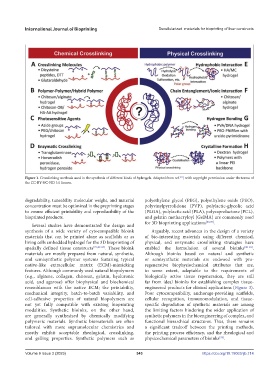Page 351 - IJB-9-3
P. 351
International Journal of Bioprinting Decellularized materials for bioprinting of liver constructs
[74]
Figure 1. Crosslinking methods used in the synthesis of different kinds of hydrogels. Adapted from ref. , with copyright permission under the terms of
the CC-BY-NC-ND 3.0 license.
degradability, tuneability molecular weight, and material polyethylene glycol (PEG), polyethylene oxide (PEO),
concentration must be optimized in the preprinting stages polyvinylpyrrolidone (PVP), polylactic-glycolic acid
to ensure efficient printability and reproducibility of the (PLGA), polylactic acid (PLA), polycaprolactone (PCL),
bioprinted products. and gelatin methacryloyl (GelMA) are commonly used
Several studies have demonstrated the design and for 3D bioprinting applications [88,89] .
synthesis of a wide variety of cytocompatible bioink Arguably, recent advances in the design of a variety
materials that can be printed alone as scaffolds or as of bio-interesting materials using different chemical,
living cells embedded hydrogel for the 3D bioprinting of physical, and enzymatic crosslinking strategies have
spatially defined tissue constructs [73,80-87] . These bioink enabled the formulation of several bioinks [90-92] .
materials are mostly prepared from natural, synthetic, Although bioinks based on natural and synthetic
and semisynthetic polymer systems featuring typical or semisynthetic materials are endowed with pro-
native-like extracellular matrix (ECM)-mimicking regenerative biophysiochemical attributes that are,
features. Although commonly used natural biopolymers to some extent, adaptable to the requirements of
(e.g., alginate, collagen, chitosan, gelatin, hyaluronic biologically active tissue regeneration, they are still
acid, and agarose) offer biophysical and biochemical far from ideal bioinks for establishing complex tissue-
resemblances with the native ECM; the printability, engineered products for clinical applications (Figure 3).
mechanical integrity, batch-to-batch variability, and Poor cytocompatibility, anchorage-providing scaffolds,
cell-adhesive properties of natural biopolymers are cellular recognition, immunomodulation, and tissue-
not yet fully compatible with existing bioprinting specific degradation of synthetic materials are among
modalities. Synthetic bioinks, on the other hand, the limiting factors hindering the wider application of
are generally synthesized by chemically modifying synthetic polymers in the bioengineering of complex, and
polymeric materials. Synthetic biomaterials are often functional hierarchical structures. Thus, there remains
tailored with more supramolecular chemistries and a significant tradeoff between the printing methods,
mostly exhibit acceptable rheological, crosslinking, the printing process efficiency, and the rheological and
and gelling properties. Synthetic polymers such as physicochemical parameters of bioinks .
[93]
Volume 9 Issue 3 (2023) 343 https://doi.org/10.18063/ijb.714

